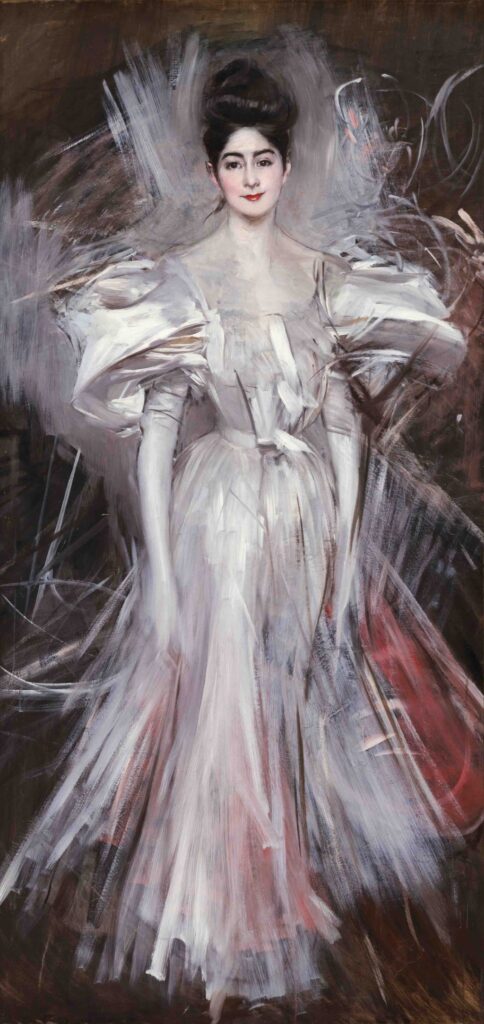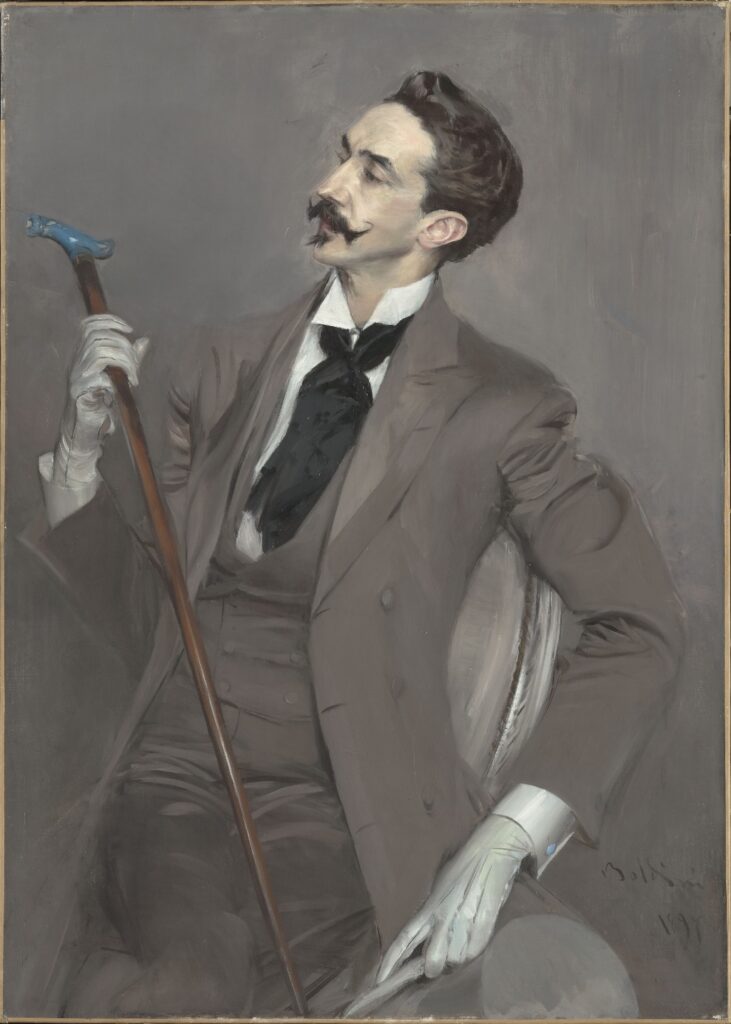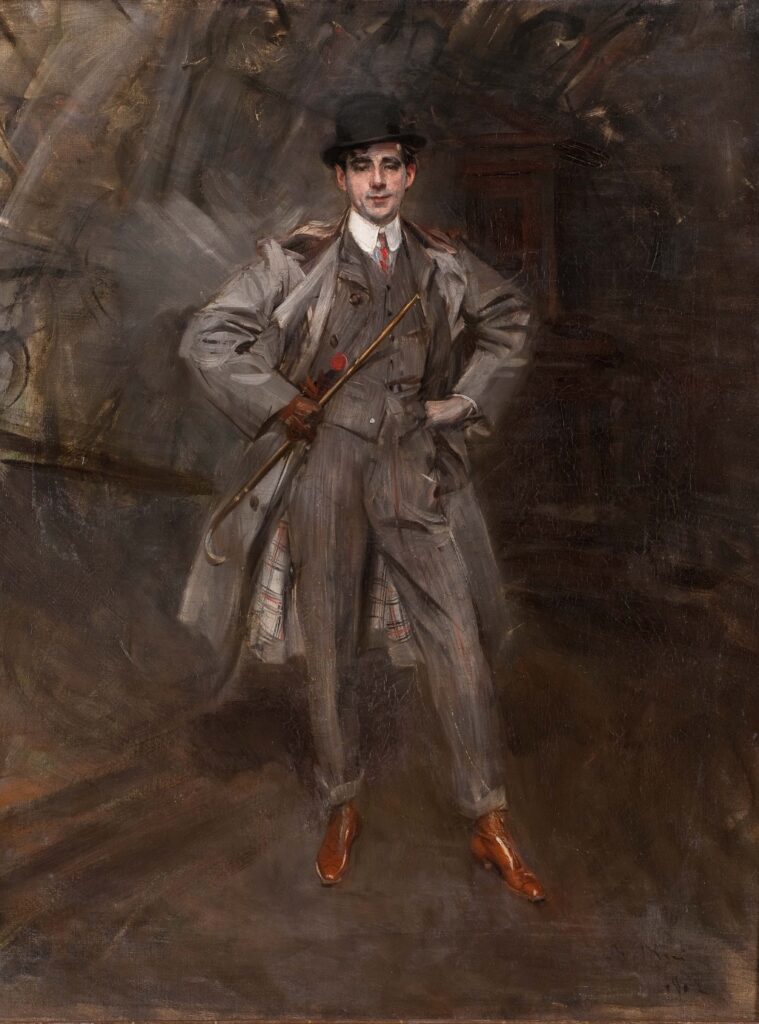
Giovanni Boldini (1842-1931), an Italian artist who spent most of his long career in Paris, was the fashion influencer par excellence of his day. Stylish Belle Époque women actually went on diets in order to be fit subjects for his elongated full-length portraits of elegant women in sumptuous gowns that splintered into explosions of silk and satin in his very expensive paintings. The popular portrait painter is now the subject of a retrospective, “Giovanni Boldini: Les Plaisirs et les Jours,” at the Petit Palais.

In 1931, the caricaturist Sem (Georges Goursat), a close friend of Boldini, described the latter’s paintings as portraits of women on the verge of a nervous breakdown: “These dazzling visions zigzag like flashes of heat, full of shivers, tremors and tensions that captured that neurotic era.”

Boldini didn’t restrict himself to painting fashionable women, however. He was also the author of the famous portrait of that effete dandy and poet, Count Robert de Montesquiou, notoriously the model for both Baron de Charlus in Marcel Proust’s In Search of Lost Time and Jean Des Esseintes in Joris-Karl Huysmans’ Against Nature.
Proust looms large in the backstory of this exhibition, whose subtitle is taken from the novelist’s first published book, Les Plaisirs et les Jours (Pleasures and Days). Both painter and writer moved in the same circles, and many of the subjects of Boldini’s paintings also served as models for characters in Proust’s great novel, among them Countess Greffulhe (Duchesse de Guermantes in the novel) and Madeleine Lemaire (Mme. Verdurin).
John Singer Sargent (1856-1925), another society painter, was one of Boldini’s inspirations, and the Italian artist actually moved into Sargent’s former studio in Paris’s 17th arrondissement in 1886 and remained there until his death. While Boldini borrowed Sargent’s standing pose for most of his portraits of beautiful Parisian ladies, he eventually began to stretch out their figures as a Mannerist would and to transform their glittering gowns into fireworks (as one famous portrait, pictured above, is called) of exuberantly expressive brushstrokes.

Boldini was a celebrity himself and was often seen out on the town with his bosom buddies Sem and Paul Helleu, a friend of Proust’s and a model for the painter Elstir in his novel.
While the portraits dominate the exhibition, they don’t tell Boldini’s whole story. I preferred the beginning of the show, which featured small genre paintings that demonstrated the artist’s talent for capturing action and casual poses, with a number of Parisian scenes, like the one pictured at the top of this page, that are wonderfully but not slavishly detailed and full of life.
I have to agree with Sem, who said in 1931, “Certainly, I admire his large paintings, but my devotion goes to his small studies, to his nature sketches and marvelous watercolors. In the small works, his condensed genius explodes as if detonated.”
Some of the most moving paintings here are the simplest: a study of Calville apples (c. 1907); the portrait of a gardener (c. 1897) smoking a cigarette as he relaxes on a bench with his trousers unbuttoned, painted on the inside of Boldini’s paint box; and an unpretentious portrait of the painter John Lewis Brown and his wife and daughter (1890), who are wearing their overcoats and seem to have been captured on canvas while walking toward the artist on the street, greeting him with big smiles.
While Boldini may have made a fortune from his big, splashy society portraits – in 1920, he quoted a price of between 30,000 and 50,000 francs for a portrait – his heart seems to have been elsewhere, away from the glam and glitter of high society, which, like Proust, he enjoyed mocking.
Note: This year is the centenary of the death of Marcel Proust. If you liked this show on Boldini, you will probably also enjoy the Musée Carnavalet’s excellent exhibition “Marcel Proust: Un Roman Parisien (A Parisian Novel).” Hurry, though, it ends on April 10.
Favorite
Great article about a favourite artist .
Thank you!